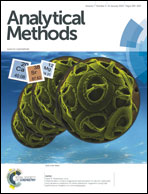A practical strategy for chemical profiling of herbal medicines using ultra-high performance liquid chromatography coupled with hybrid triple quadrupole-linear ion trap mass spectrometry: a case study of Mori Cortex†
Abstract
Herbal medicines (HMs) are believed to produce holistic action through the synergistic effects of many major and minor components. In the current study, a practical strategy was designed to comprehensively characterize the chemical constituents in HMs. Mori Cortex (MC), which contains diverse chemical constituents and consequently exhibits a broad spectrum of pharmacological activities, was chosen as a model case. The workflow included three steps: first, a thorough literature review was performed to summarize the available information about the phytochemistry and the biosynthetic pathways for the genus Morus; second, seven compounds, namely morin (polyhydroxyflavonoid), morusin (prenylflavone), mulberroside A and oxyresveratrol (stilbenes), mulberroside C (2-arylbenzofuran derivative), sanggenon C and kuwanon G (DA-type adducts), were selected to propose mass fragmentation pathways for the primary chemical types in MC; and third, a set of parent-to-parent ion transitions was constructed using quasi-molecular and sodium adduct ions of the identified compounds and their potential derivatives, and the multiple ion monitoring-information dependent acquiring-enhanced product ion (MIM-IDA-EPI) method was thereby used to detect and identify the constituents. As a result, a total of 140 components were detected with 133 identified in the MC extract, including 10 polyhydroxyflavonoids, 4 stilbenes, 16 2-arylbenzofuran derivatives, 60 prenylflavones, and 43 DA type adducts, while the identities of 7 components could not be elucidated due to insufficient structural information. Collectively, the strategy was demonstrated to be efficient, reliable and sensitive for global chemical profiling of HMs.


 Please wait while we load your content...
Please wait while we load your content...